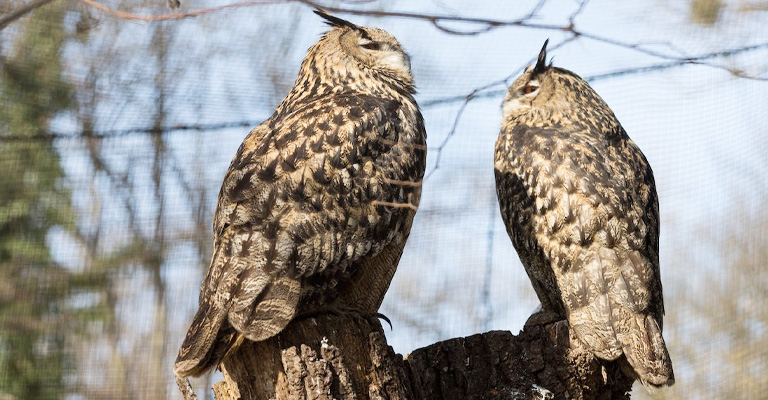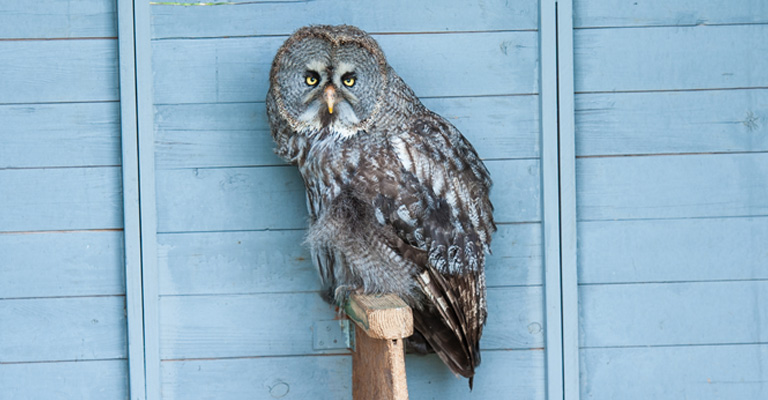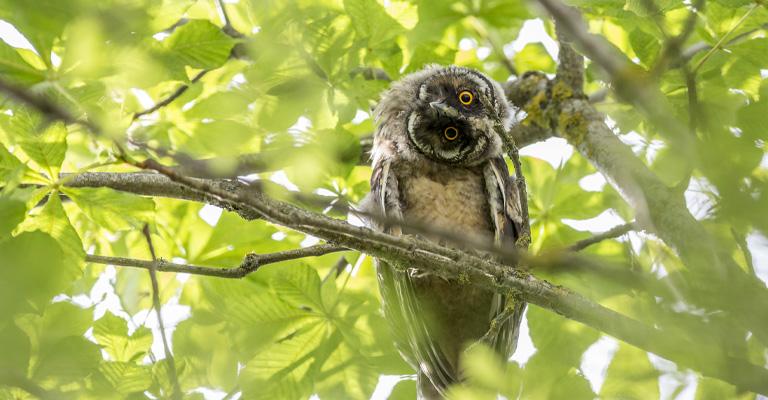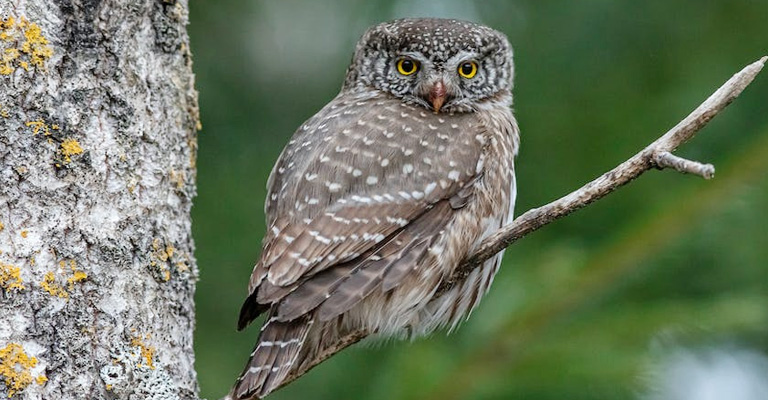The haunting hoots and eerie calls of owls have captivated the human imagination for centuries. These nocturnal birds of prey possess a unique vocal repertoire that sets them apart from other avian species.
But what is the reason for owls having such a distinctive sound? In this exploration, we delve into the fascinating world of owl vocalizations to uncover the reasons behind their unmistakable sounds.
From the iconic “hoot” to the spine-chilling screeches, we will unravel the mysteries behind these auditory marvels. Owls have evolved specialized adaptations that contribute to their distinctive vocalizations.
These vocalizations serve various purposes, including territorial defense, courtship displays, and communication with their young.
Join us as we embark on a journey to understand the reasons behind the captivating sounds of owls. Discover the fascinating adaptations and behaviors that contribute to their vocal prowess, shedding light on the secrets of these enigmatic creatures of the night.

What Is the Reason for Owls Having Such a Distinctive Sound?
From their haunting hoots to spine-chilling screeches, owls possess a vocal repertoire that sets them apart from other avian species. Let’s dive into the reasons behind the distinctive sound of owls:
Vocal Adaptations
Owls have evolved specialized vocal adaptations that enable them to produce their characteristic sounds. These adaptations include:
- Syrinx: Owls possess a unique vocal organ called the syrinx, located at the base of their trachea. This complex structure allows for precise control over sound production, resulting in a wide range of vocalizations.
- Asymmetrical Ears: Owls have asymmetrical ear openings, with one ear positioned higher than the other. This arrangement enhances their ability to locate and pinpoint sounds, aiding in their hunting and communication.
Anatomical Features
Specific anatomical features contribute to the distinctive sound of owls, such as:
- Facial Disc: Owls have a facial disc, a circular arrangement of feathers around their face. This disc acts as a sound reflector, directing and focusing sound waves toward their ears, enhancing their hearing abilities.
- Feather Structure: The unique structure of owl feathers helps to reduce noise during flight, allowing them to approach prey silently.
Communication and Adaptation
The distinctive sound of owls serves various purposes in their lives, including:
- Territorial Defense: Owls use vocalizations to establish and defend their territories, warning other owls to stay away.
- Courtship Displays: Male owls often utilize elaborate vocalizations during courtship displays to attract females and establish their suitability as mates.
- Parent-Offspring Communication: Owls use specific calls to communicate with their young, facilitating bonding and teaching important survival skills.
Overall, the distinctive sound of owls is a result of their specialized vocal adaptations, unique anatomical features, and the various purposes their vocalizations serve.
These adaptations and behaviors have allowed owls to thrive in their environments and establish their presence through their unmistakable calls.
Factors That Contribute to the Unique Vocals of Owls

Owls have unique vocals that are influenced by several factors. Here are some key factors that contribute to the distinct vocalizations of owls:
Anatomy
Owls have specialized vocal anatomy that allows them to produce unique sounds. They possess a structure called the syrinx, which is located at the base of their trachea.
The syrinx is responsible for producing sounds in birds and is more complex in owls compared to other bird species. This complexity enables owls to create a wide range of vocalizations.
Adaptation to Nocturnal Lifestyle
Owls are primarily nocturnal creatures, and their vocalizations have evolved to suit their nighttime activities.
Their calls are designed to carry over long distances in the dark, allowing them to communicate with other owls and establish territories without relying on visual cues.
Species-specific Communication
Different owl species have distinct vocalizations that serve various purposes. For example, the hooting calls of the great horned owl (Bubo virginianus) are used for territorial defense and attracting mates.
On the other hand, the screeches and screams of the barn owl (Tyto alba) are used for hunting and locating prey.
Individual Variation
Just like humans, owls have individual variations in their vocalizations. Each owl has a unique voice, which can be influenced by factors such as age, sex, and individual characteristics.
This individuality helps owls recognize each other and maintain social bonds within their populations.
Environmental Factors
The environment in which owls live can also influence their vocalizations. Factors such as habitat type, availability of prey, and presence of other owl species can shape the specific calls and vocal patterns of owls in a particular area.
The unique vocals of owls are a result of their specialized anatomy, adaptation to nocturnal life, species-specific communication needs, individual variation, and environmental factors. These factors work together to create the diverse and fascinating vocal repertoire of owls.
Why Do Owls Hoot?

Owls hoot for various reasons, and their hooting serves several important purposes. Here are some common reasons why owls hoot:
Territory Defense
One primary reason owls hoot is to establish and defend their territories. By hooting, owls communicate their presence to other owls in the area, signaling that the territory is already occupied. This helps prevent conflicts and reduces the need for direct physical confrontations.
Mating Calls
Hooting is also a way for owls to attract mates during the breeding season. Male owls often hoot to advertise their presence and availability to potential female partners.
The hooting calls can be quite elaborate and distinctive, allowing owls to recognize and locate each other for mating purposes.
Communication with Family Members
Owls also use hooting as a means of communication within their family groups. For example, parent owls may hoot to communicate with their offspring, signaling their location or calling them for food. This helps maintain social bonds and coordinate activities within the owl family.
Vocalizing Presence
Hooting can serve as a general vocalization to announce an owl’s presence in the area. This can be important for owls that are active during the night, as it allows them to communicate with other owls without relying on visual cues.
By hooting, owls can establish their presence and avoid accidental encounters with other owls.
Warning or Defense
In some cases, owls may hoot as a warning or defensive response to potential threats. When they feel threatened or disturbed, owls may emit hooting calls to intimidate or deter predators or intruders.
This vocalization can serve as a way to assert dominance and protect themselves or their nests.
Hunting
Owls are skilled nocturnal hunters, and sound plays a crucial role in their hunting strategy. Their exceptional hearing allows them to locate prey in complete darkness.
Owls have asymmetrical ear placements, with one ear higher than the other, which helps them pinpoint the exact location of sounds.
They can detect even the slightest rustle or movement made by potential prey, such as small mammals or birds. Once they locate their prey, owls use their sharp talons and powerful beaks to capture and consume it.
Locating Prey
Owls use sound to locate prey that may be hidden or camouflaged. They emit high-pitched calls or screeches and listen for the echoes that bounce back.
This technique, known as echolocation, helps owls determine the distance, direction, and size of their prey. By interpreting the echoes, owls can accurately locate and strike their prey, even in complete darkness.
What Types of Sounds Do Owls Make?

Owls produce a variety of sounds, each serving a different purpose. Here are some common types of sounds that owls make:
Hoots
Hooting is the most well-known vocalization of owls. It is a deep, resonant sound that is often associated with owls. Hoots can vary in pitch, duration, and rhythm depending on the owl species.
Hooting is primarily used for territorial defense, attracting mates, and communication within owl families.
Screeches
Screeching calls are high-pitched and piercing sounds that owls use for various reasons. Screeches can serve as alarm calls to warn of potential threats or as aggressive vocalizations during territorial disputes. Barn owls, in particular, are known for their distinctive screeching calls.
Whistles
Some owl species produce whistling sounds, which can be melodic or shrill. These whistles are often used for communication between owls, especially during courtship or when locating family members. The Eastern screech owl is known for its trilling whistle-like call.
Bill Snaps
Owls can produce snapping sounds with their beaks, which serve as a defensive or aggressive vocalization. Bill snaps are sharp, clicking sounds that owls use to intimidate predators or intruders.
This behavior is often accompanied by other defensive postures, such as hissing or puffing up their feathers.
Hisses
When threatened or disturbed, some owls emit hissing sounds. Hissing is a warning vocalization that owls use to deter potential threats.
It is often accompanied by defensive postures, such as spreading their wings or raising their feathers to appear larger and more intimidating.
Chirps and Trills
Some owl species produce chirping or trilling sounds, which are softer and more musical compared to hoots or screeches. These sounds are often used for communication within owl families or during courtship displays.
FAQs
The distance at which an owl’s hoot can be heard depends on various factors, including the species of owl, the environment, and atmospheric conditions. On average, owls’ hoots can be heard up to a few miles away.
No, not all owls hoot. While hooting is a common vocalization among many owl species, some owls have different vocalizations.
For example, the barn owl produces screeching sounds, the Eastern screech owl produces trilling whistles, and the burrowing owl makes a variety of chirping and cooing sounds.
While owls are not known for their mimicry abilities like some other bird species, there have been rare instances of owls imitating sounds in their environment. For example, the northern saw-whet owl has been observed imitating the calls of other bird species.
Yes, owls can produce sounds other than vocalizations. For example, owls can make wing noises when flying, such as the soft fluttering of feathers or the sound of their wings gliding through the air.
Owls have excellent hearing abilities, but they cannot hear ultrasonic sounds. While some owl species, like the barn owl, are known for their ability to detect and locate prey using echolocation, their hearing range typically extends up to the upper limit of human hearing, which is around 20,000 Hz.
Parting Thoughts
The distinctive sound of owls is a result of their specialized vocal adaptations and unique anatomical features.
Their haunting hoots and eerie calls serve important purposes in their lives, from territorial defense to courtship displays and communication with their young.
By unraveling the mysteries behind owl vocalizations, we gain a deeper appreciation for these remarkable creatures and their ability to communicate through sound.
Their unique sound-producing structures, such as the syrinx, combined with specific anatomical features, allow them to create a wide range of sounds with precision and clarity.
Next time you hear the haunting hoots of an owl in the night, take a moment to marvel at the intricate mechanisms behind their vocalizations. The distinctive sound of owls serves as a reminder of the beauty and diversity found in the natural world.